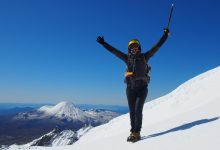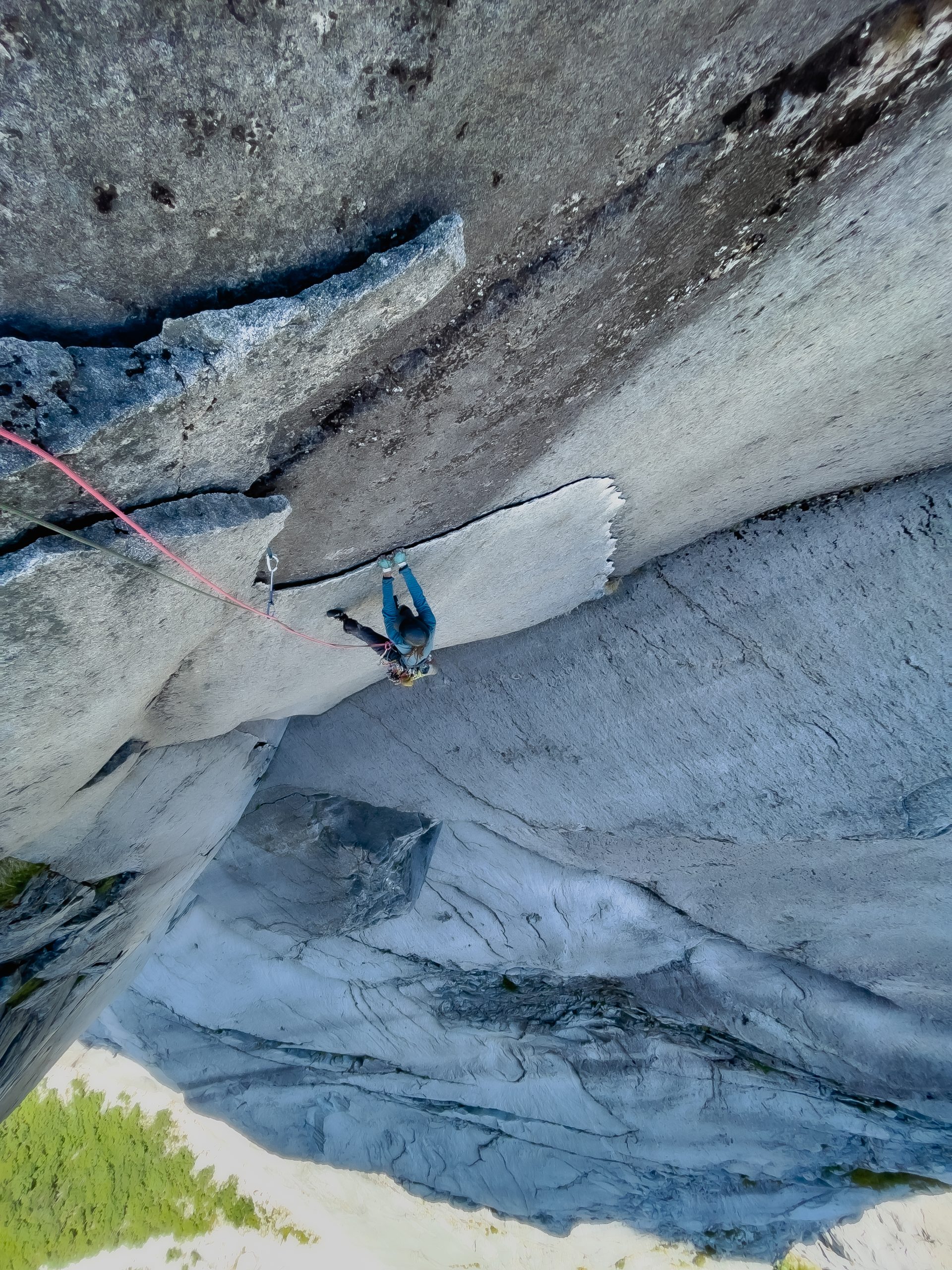
Place your foot on the blank rock-face. Ease your weight onto it as you hold your breath and squeeze your insides. Don’t think about how far you’d fall if your foot slips.
This is slab climbing, moving up on a featureless part of a less-than-vertical wall. There are no holds, nothing to grab and pull yourself higher. It’s all balance and footwork. It feels impossible, or, at best, highly improbable.
Your heart hangs in your mouth as you carefully weight your foot. This eases the pressure on your other foot, which may or may not upset the magical formula that is, for the moment, keeping you attached to the wall.
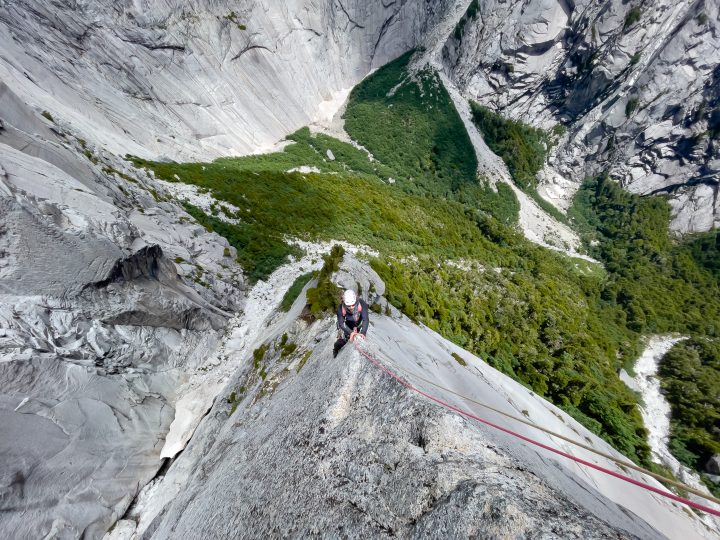
If done well, it feels like levitating, but there’s a fine line between heart-in-mouth terror and levitation, a line I became very familiar with in Cochamó, Chile. The granite cliffs of this mountain-filled valley in northern Patagonia, sometimes called the Yosemite of the south, are full of discontinuous cracks and corners that are linked via blank, steep slabs.
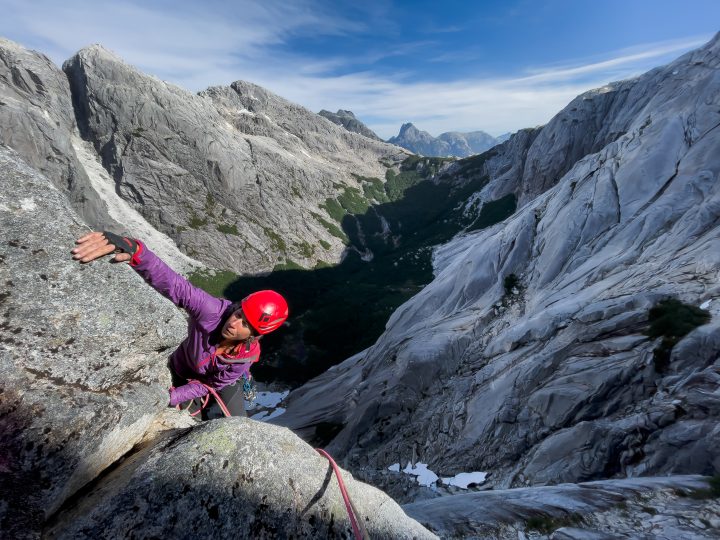
I had an early taste of this on one of our first climbing days. We were on the first pitch of a route called Surfing For Stone, rated ‘R?’, indicating the potential for an ugly fall due to sparse gear protection. I had climbed through the wet chimney at the bottom, and was searching for somewhere to place said protection. One moment, my foot was smearing on the rock. The next, it slipped and sent me tumbling down into the chimney, my torso inverting after I tripped on the rope behind my leg.
The rope eventually came tight, arresting my fall several metres below. I gathered myself, assessed the damage. Mostly scot-free, aside from a banged-up elbow. Up I continued, beyond the place where I’d fallen, and then up a hand-crack as the wall steepened.
It started to drizzle as I started up another featureless section, my feet clinging to the blank wall, my heart in my mouth. Wet rock and friction are not natural bedfellows. My foot popped, spinning me sideways into a 10m bum-slide that ripped up my soft-shell pants, underwear and butt-cheek.
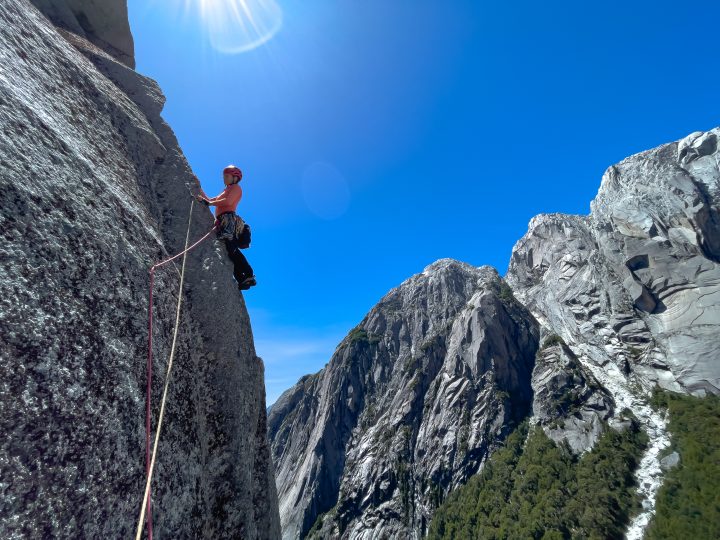
With a bruised body and ego, my will to continue dissipated as the skies opened. Down I went, tail between my legs, leaving behind gear to be retrieved another day.
It was an abrupt introduction to a unique place that appeals to those who love the high and the wild. Cochamó is not your everyday holiday climbing destination, where you clip some bolts on a nearby cliff and then stroll to the local for sunset beers. Here, the only weather updates come via radio. There’s no helicopter coming to rescue you if something goes wrong. And aside from occasional bread cooked at one of the campsites, the only food is what’s carried in.
Such an isolated place might seem like a deterrent, but there are undeniable benefits to unplugging. No faces glued to phones. A simplified life, a re-wilding, connecting only with what’s in front of you and letting everything else fall away.
Access starts at the end of a dirt road, where horses ferry up to 60kg of gear up a 12km trail to the campsites near the confluence of two rivers. These sites, where climbers set up basecamp, are surrounded by impressive cirques of granite. There’s El Anfiteatro to the south, Trinidad to the south east, La Junta and La Paloma to the north, Arco Iris to the west—each sector with several peaks, rock-faces up to 1400m high, and a number of established routes, as well as innumerable ones yet to be developed.
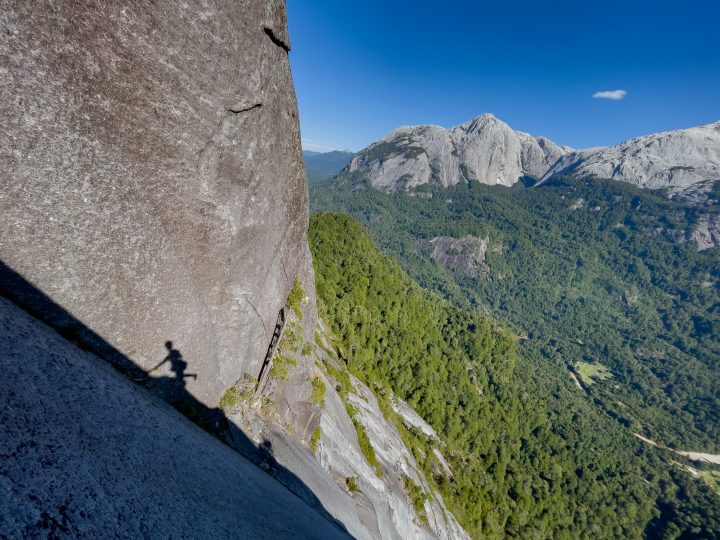
An abundance of classics awaits in Anfiteatro, where climbers sleep under an enormous boulder just above the treeline. The rock-walls seem to lean in and look down on you from every direction. There’s Luchando con Mariposas (translation: ‘Fighting with Butterflies’), which includes several slab pitches to test your gecko footwork; La Aleta de Triburón (‘The Shark’s Fin’), which has a stunning aréte with gulp-fuls of exposure; Al Centro y Adentro (‘To the centre, and inside’), which follows a crack system that eats your fingers, hands, fists and, at times, your whole body. The crux pitch of the latter, of course, tests your gecko abilities on featureless rock.
The bivvy boulder in Trinidad is in the forest, but no less magical. Several mountains encircle, providing the day’s adventure: a thin seam guards the top-out of No Hay Hoyes (‘There are no todays’); a long corner system demands all manner of grovelling on Homo Santa (‘the Santa species’); the overhanging fist-crack on Der Grantler (‘The Grumbler’) will leave you breathless and weary, as will the steep and enormous flake you have to traverse on Las Manos del Dia (‘The Hands of the Day’).

It became a familiar routine to do battle with the climbs throughout the day and plod back to our bivvy spot by headtorch, fatigue seeping through every pore. We then collapsed in a happy daze by the campfire as someone passed around that evening’s shared dinner; rice and lentils one night, freshly-mashed garlic hummus with fresh, fire-baked bread the next.
As nurturing as this was, Cochamó is rapidly changing as it becomes a household name among the international climbing community. Ten years ago there was no nearby township, and climbers arrived to a handful of farms in the countryside, knocking on locals’ doors to ask to buy food and for a ride to the trailhead. Only hundreds of people a day occupied two campsites during the summer months. Today there are still no cafes or power lines, but there’s a small shop (selling exorbitantly-priced bananas and satellite internet) and five campsites, with daily visitor numbers in the thousands.

And then there’s the constant fight to stave off industrial development. Much of the land east of the river, which includes Anfiteatro and Trinidad, is owned by Chilean businessman Roberto Hagemann. The company where he owns most of the shares, Mediteráneo SA, has tried to gain consent for a hydroelectric power-plant. Previous attempts to install dams have been similarly blocked, thanks to the diligent efforts of local and international NGOs.
The good news is that, earlier this year, Cochamó was declared a nature sanctuary, protecting an 11,000 hectare area of native forest. The designation is thought to make the area less vulnerable to real estate development, hydroelectric dams and uncontrolled tourism, but with two caveats: a management plan and governance model are yet to be developed, and the protected area does not include Hagemann’s land—which he is now trying to sell, for hundreds of millions of dollars—nor a vast chunk of the climbing area.
The underlying question is this: how much development is too much, or, put another way, how wild do we want our wild places to remain? As soon as humans encroach on a new place, some of that wildness is lost. If we allow visitors, how do we interact with the land while also preserving its beauty? How many is too many, and if we restrict numbers, how can that be done equitably?
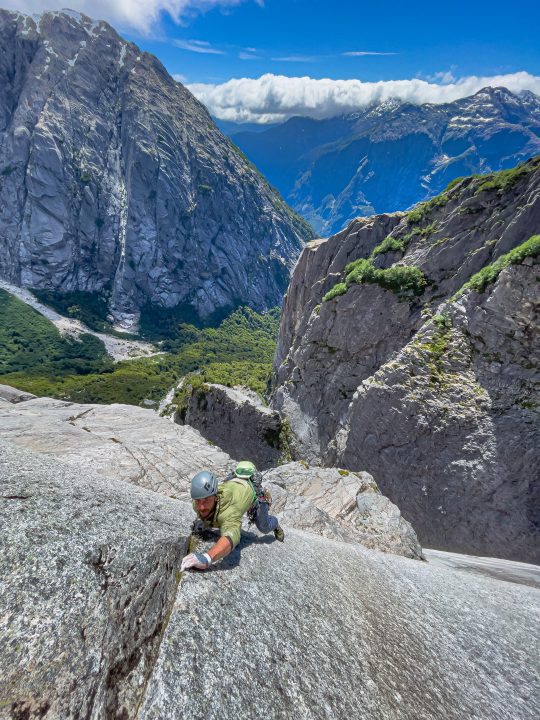
The balancing act between conservation and tourism is also playing out in New Zealand, where the multi-billion dollar tourism industry is trying to gain back what it lost in the Covid pandemic. Draft National Park management plans could open the door to a gondola in Franz Joseph, and a far greater number of flights in Aoraki / Mt Cook. The plans for those areas are currently being redrafted in light of the Supreme Court’s Ngāi Tai ki Tāmaki decision, in December 2018, which clarified the role of iwi in government conservation plans. The new draft plan for Aoraki / Mt Cook is due to be released later this year, while the new timeline for Westland Tai Poutini is yet to be announced.
In the meantime, it seems like we should be exploring the high and wild while they remain relatively free of the masses. Cochamó is still such a place, with its sky-scorching condors high above native alerce forests, pristine pools, rushing rivers, and walls of endless granite.
One of my last climbs there was on a route called Gardens of the Galaxy, a 840m climb up the La Junta peak. The first pitch required some delicate climbing around a wet streak. The crux pitch demanded some forceful pulling on a thin flake, followed by some wishful stemming up a blank corner. Steep slab protected the higher portions of the climb, and my best gecko impressions were not enough to prevent the odd fall.
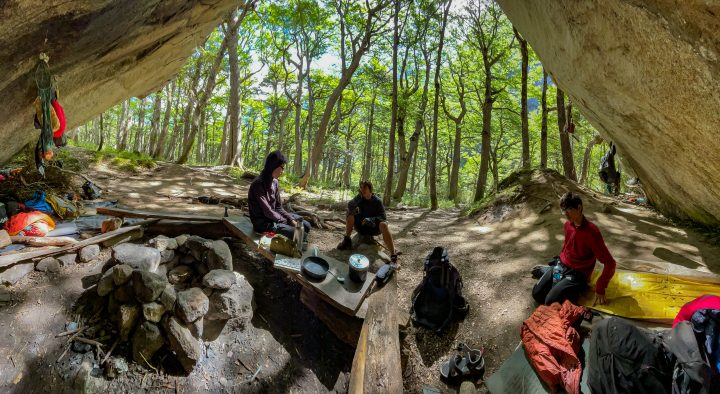
We failed to top out, but that mattered little as the sun set, bathing the valley in alpenglow as we descended. The forest below was thriving with bird-song. Above, the clouds swept over the summits as snowmelt fed the river below. We were but tiny specks in this immense place, the only people on the mountain. It was as if this magical place existed for us—and us only.
Words and photos by Derek Cheng







